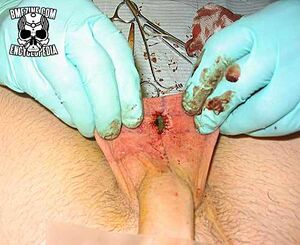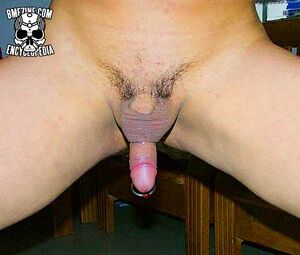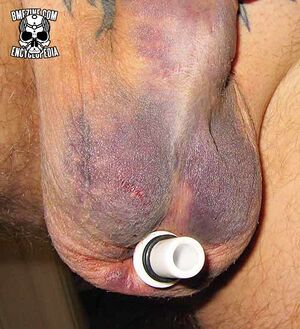Transscrotal
Transscrotal piercings (also transcrotal, or scrunnel—short for scrotal tunnel) are piercings which travel into the inner body of the scrotum and then out again. Generally, this means that they travel right through the scrotum from front to back.
The problem with transscrotal piercings is that a scrotal infection can occur, which means the infection bypasses the body's first line of defense—your skin — and can very quickly become dangerous. Because of this, most people treat transscrotals as a surgical procedure in which a fistula must be created for the piercing to be viable.
To simplify, the scrotum is first clamped. An incision is made with a scalpel (or sometimes a dermal punch), and the skin on the front is sutured to the skin on the back. Correct stitching is essential for safe and effective healing. Of the three layers of tissue that compose the scrotum (skin, muscle, and membrane), only the skin layers should be stitched together. If any of the other layers are attached, healing can be difficult or impossible. Jewelry is inserted into this fresh hole which is usually between 2 gauge and half an inch, but can be much larger. If the bond between the front and back skin holds, transscrotals can heal very quickly—within a few weeks. However, if the bond does not hold, healing can take a very long time and be very problematic. So, it's essential to get the procedure right!
Once healed, transscrotal piercings can also be stretched very quickly.
Transscrotal piercings done using a standard piercing technique (ie. needle and jewelry follow-through) rarely fully heal, and when if they do, take an incredibly long time to do so (and also will not stretch as easily).
The most common complaint people have about their transscrotal (besides the occasional pinching) is placement—a majority of people later decide that their placement is too low. The picture to the right (by Jon Cobb, one of the first proponents of this piercing) shows an ideal placement, whereas the heavily bruised (healing) one beneath it shows a very low placement—if you want a placement like that, it's easier just to do a normal scrotal piercing which looks almost the same.
Getting the perfect placement is made much, much easier by first doing some scrotal stretching so the piercing can be placed above rather than below or between the testicles.



